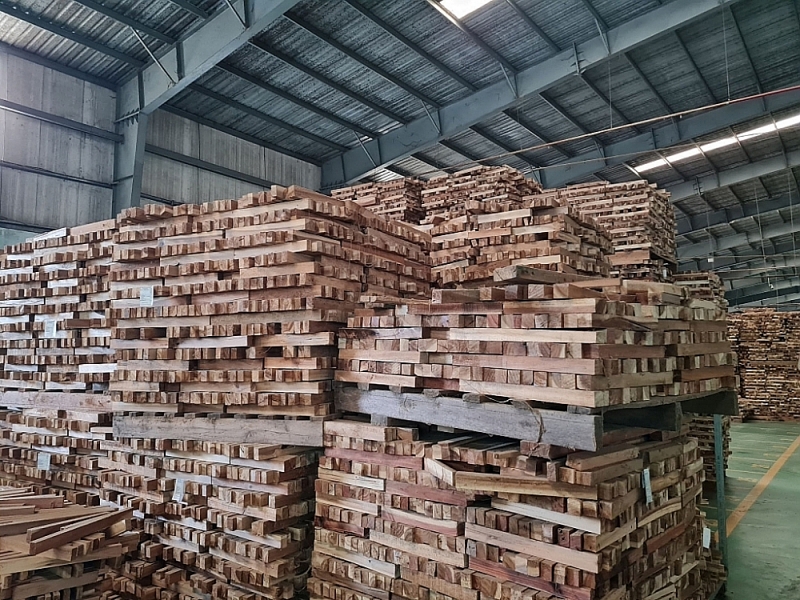Risks surrounding the wood industry in the coming quarters
In addition to the export of wood and wood products decreasing by 28.3% in the first quarter of 2023 compared to the same period in 2022, many signals in the world market showed that the import and export dynamics of the wood industry would not be too volatile compared to the fourth quarter of 2022 and the first months of 2023.
 |
|
VIFOREST expected that the wood industry's export would continuously face a market contraction in the near future. Photo: Nguyen Thanh |
Many factors affect global supply-demand
According to the General Department of Customs, it is estimated that in March 2023, the export turnover of wood and wood products reached US$1.2 billion, up 36.3% compared to February 2023, but down 22. 8% compared to March 2022. In which, the export turnover of wood products is estimated at US$823 million, up 47.7% compared to February 2023 but down 30% compared to March 2022. Generally in the first three months of 2023, the export turnover of wood and wood products is estimated at US$2.88 billion, down 28.3% over the same period in 2022. The above figures showed that the wood industry was experiencing a significant decrease compared to the same period in 2022.
According to the Vietnam Timber and Forest Products Association (VIFOREST), the world economy is facing difficulties and challenges; global purchasing power has decreased, leading to a sharp decrease in the number of orders in the wood industry compared to the same period in 2022. Currently, businesses have small orders and only received orders until June 2023.
“Usually by this time, businesses have ordered outdoor furniture and are preparing materials until May, goods must be finished in June, then exported to Europe in November and December to be sold in the summer, but so far the business has not received orders. Because importers have a lot of inventory, only those items that have low inventories and have new customers will get orders," said VIFOREST.
Besides, the world economic context has not changed much, the main factors affecting the world's demand and supply are available. Specifically, inflation in Vietnam's main export markets such as the US and the EU is still high. This limit s spending on non-essential items, including timber and wood products. Although these countries are trying to control inflation, there is no sign that inflation will decrease in the future.
Additionally, the real estate industry in these markets is in a quiet stage, while Vietnam's export of wood products depends heavily on the operation of this industry, so it can be forecast that there would be no signs of prosperity in 2023. Simultaneously, the Russia-Ukraine war, which is still protracted and shows no sign of ending, continues to negatively impact commodity prices, reducing overall consumer demand.
The market cools down
According to experts, although traditional markets such as China, Japan, and South Korea have high stability, the export items to these three markets are relatively narrow, with only items such as wood chips, pellets, plywood, and some other items. Although in 2022 there has been strong growth in exports of these products, especially wood chips exported to China and pellets exported to Korea and Japan, market signals in recent months (quarter 1/2023) have shown that the demand for these products had signs of cooling down.
Despite the fact that Vietnam is in the top five largest wood furniture exporting countries in the world, it only exports more than US$16 billion/year. In addition, Vietnam has mainly exported to traditional markets such as the US, the EU, Korea, and Japan, and other potential markets are still open.
Notably, besides being a large market in Vietnam's export of wood and wood products, China is Vietnam's main competitor in the US market for wooden furniture (the two countries have the same market share in the US, at 31%). Therefore, the reopening of China's economy will cause difficulties for wood businesses in 2023. Meanwhile, the US is the main export market accounting for nearly 80% of the total export turnover of wooden furniture of Vietnam. When the purchasing power of this market decreases, it immediately affects the overall export results of the whole furniture industry.
Moreover, wood supplies from Africa, Laos, and Cambodia will continue to be high-risk sources. The supply of logs and sawn timber from Africa is likely to decline after the decision to include Pterocarpus, Afzelia, and Khaya in Appendix II of CITES which took effect from the end of February 2023. Along with that, the supply of birch wood from Russia has potential uncertainties for the industry, especially for export. Hence, domestic enterprises and craft villages need to prepare to deal with possible risks to these supplies.
With the above factors, VIFOREST expected that the next quarters of 2023 would not have many changes for the wood industry. Wood industry exports will continue to face a decline of the market.
Besides, items such as kitchen cabinets, bathroom cabinets, plywood, and items made from birch wood originating from Russia will continuously face the risks of tariffs or trade barriers from punitive policies in Western export markets.










